Safe Patient Handling and Mobilization: A Nursing Report Analysis
VerifiedAdded on 2022/10/19
|13
|3122
|297
Report
AI Summary
This report provides a comprehensive overview of safe patient handling and mobilization (SPHM) in nursing, addressing the critical issue of musculoskeletal disorders (MSDs) among nurses and the importance of patient safety. It begins with an introduction to the challenges of patient handling, including lifting, repositioning, and shifting, and highlights the limitations of traditional techniques. The report then reviews literature, including articles that discuss the impact of negligence in patient handling and the benefits of SPHM programs in reducing MSD risks. The report covers engineering, administrative, and behavioral-based solutions, offering a critical analysis of the articles and the introduction of the SPHM concept. The report also examines fall risks, safety considerations, and the need for workplace safety for nursing staff. The report concludes by emphasizing the importance of SPHM and its role in enhancing patient safety and mobilization, and promoting a culture of safety within healthcare settings. The learning outcomes of this report include the ability to evaluate, critique, and analyze the risks and injuries associated with patient handling.
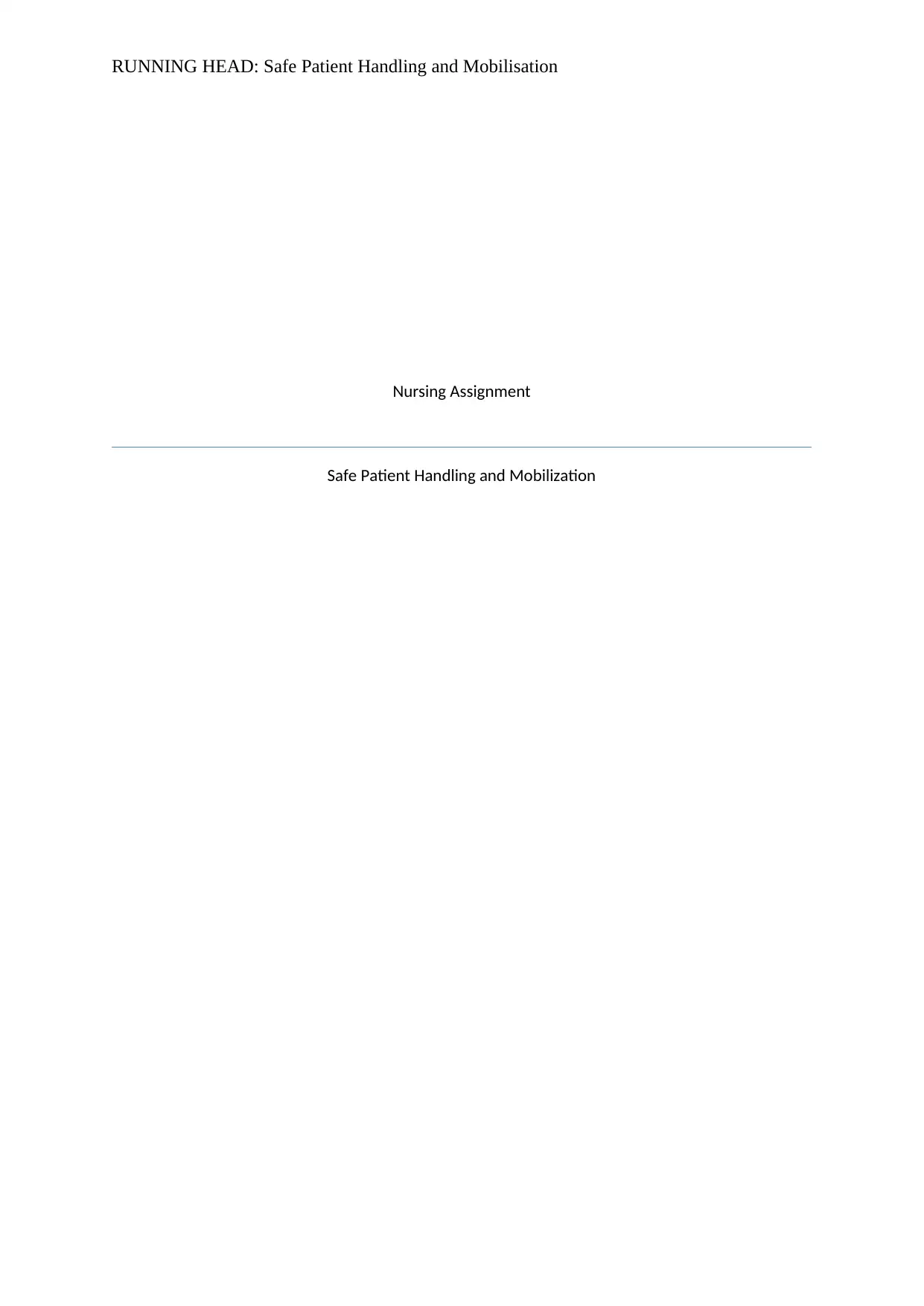
RUNNING HEAD: Safe Patient Handling and Mobilisation
Nursing Assignment
Safe Patient Handling and Mobilization
Nursing Assignment
Safe Patient Handling and Mobilization
Paraphrase This Document
Need a fresh take? Get an instant paraphrase of this document with our AI Paraphraser
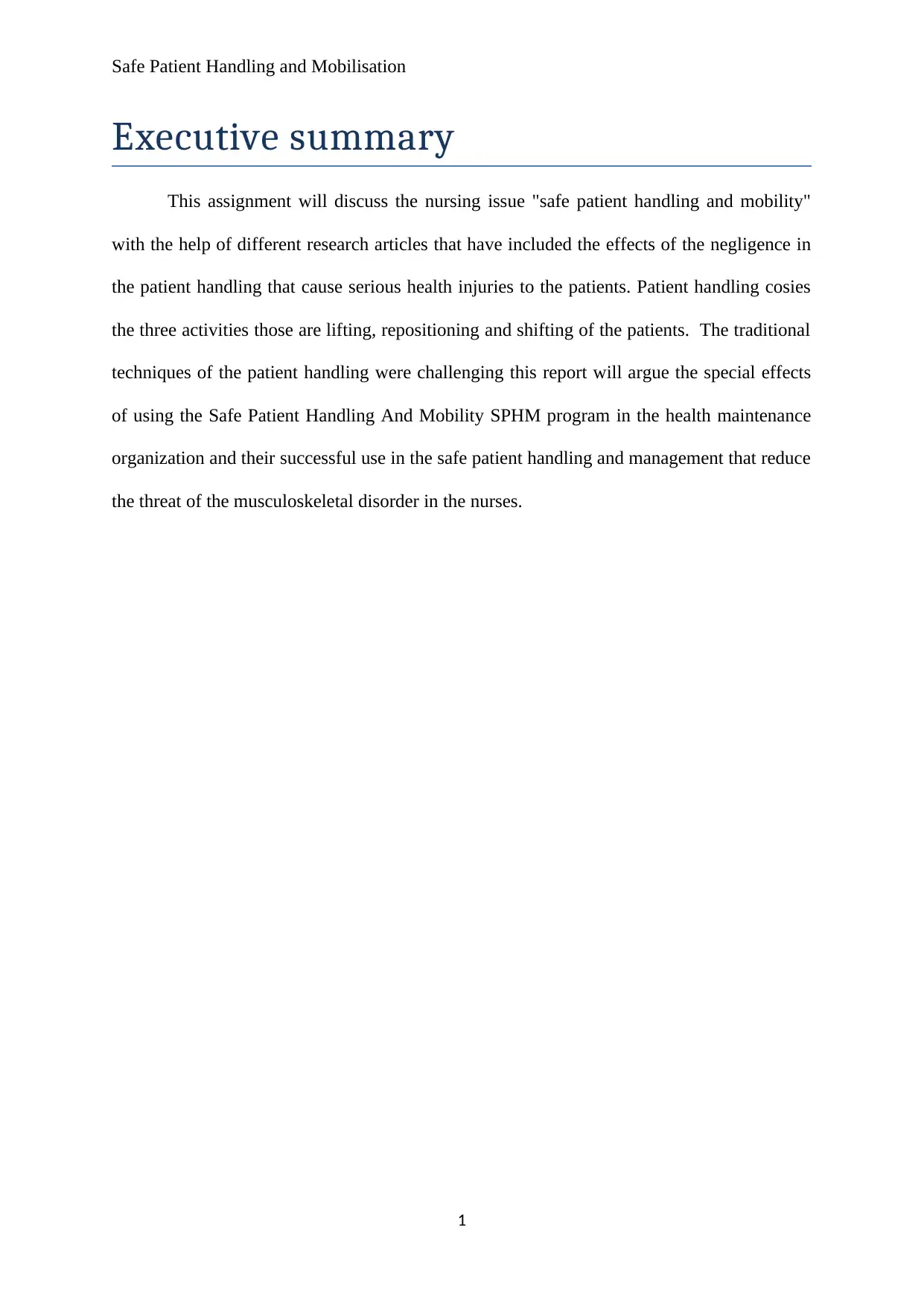
Safe Patient Handling and Mobilisation
Executive summary
This assignment will discuss the nursing issue "safe patient handling and mobility"
with the help of different research articles that have included the effects of the negligence in
the patient handling that cause serious health injuries to the patients. Patient handling cosies
the three activities those are lifting, repositioning and shifting of the patients. The traditional
techniques of the patient handling were challenging this report will argue the special effects
of using the Safe Patient Handling And Mobility SPHM program in the health maintenance
organization and their successful use in the safe patient handling and management that reduce
the threat of the musculoskeletal disorder in the nurses.
1
Executive summary
This assignment will discuss the nursing issue "safe patient handling and mobility"
with the help of different research articles that have included the effects of the negligence in
the patient handling that cause serious health injuries to the patients. Patient handling cosies
the three activities those are lifting, repositioning and shifting of the patients. The traditional
techniques of the patient handling were challenging this report will argue the special effects
of using the Safe Patient Handling And Mobility SPHM program in the health maintenance
organization and their successful use in the safe patient handling and management that reduce
the threat of the musculoskeletal disorder in the nurses.
1
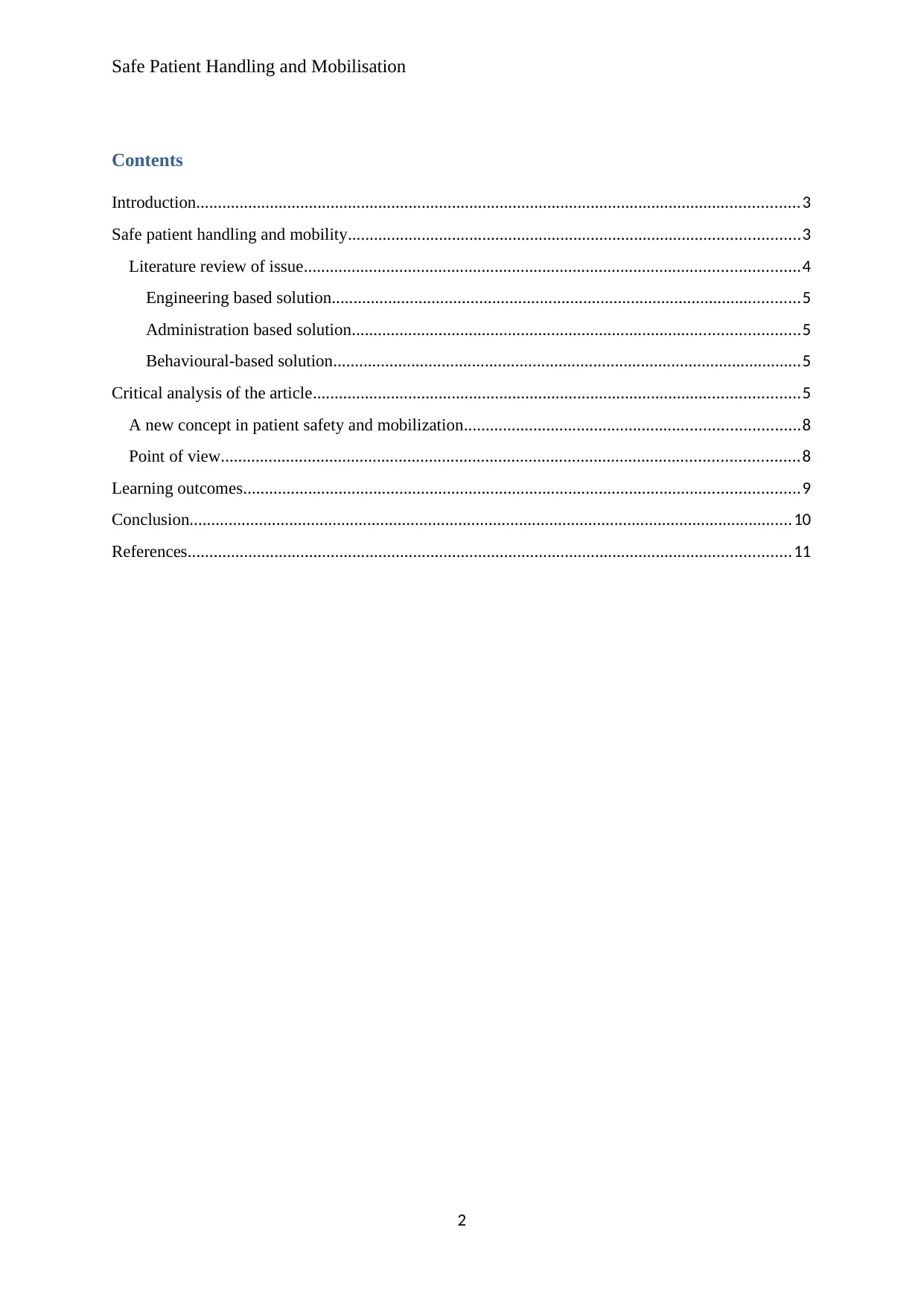
Safe Patient Handling and Mobilisation
Contents
Introduction...........................................................................................................................................3
Safe patient handling and mobility........................................................................................................3
Literature review of issue..................................................................................................................4
Engineering based solution............................................................................................................5
Administration based solution.......................................................................................................5
Behavioural-based solution............................................................................................................5
Critical analysis of the article................................................................................................................5
A new concept in patient safety and mobilization.............................................................................8
Point of view.....................................................................................................................................8
Learning outcomes................................................................................................................................9
Conclusion...........................................................................................................................................10
References...........................................................................................................................................11
2
Contents
Introduction...........................................................................................................................................3
Safe patient handling and mobility........................................................................................................3
Literature review of issue..................................................................................................................4
Engineering based solution............................................................................................................5
Administration based solution.......................................................................................................5
Behavioural-based solution............................................................................................................5
Critical analysis of the article................................................................................................................5
A new concept in patient safety and mobilization.............................................................................8
Point of view.....................................................................................................................................8
Learning outcomes................................................................................................................................9
Conclusion...........................................................................................................................................10
References...........................................................................................................................................11
2
⊘ This is a preview!⊘
Do you want full access?
Subscribe today to unlock all pages.

Trusted by 1+ million students worldwide
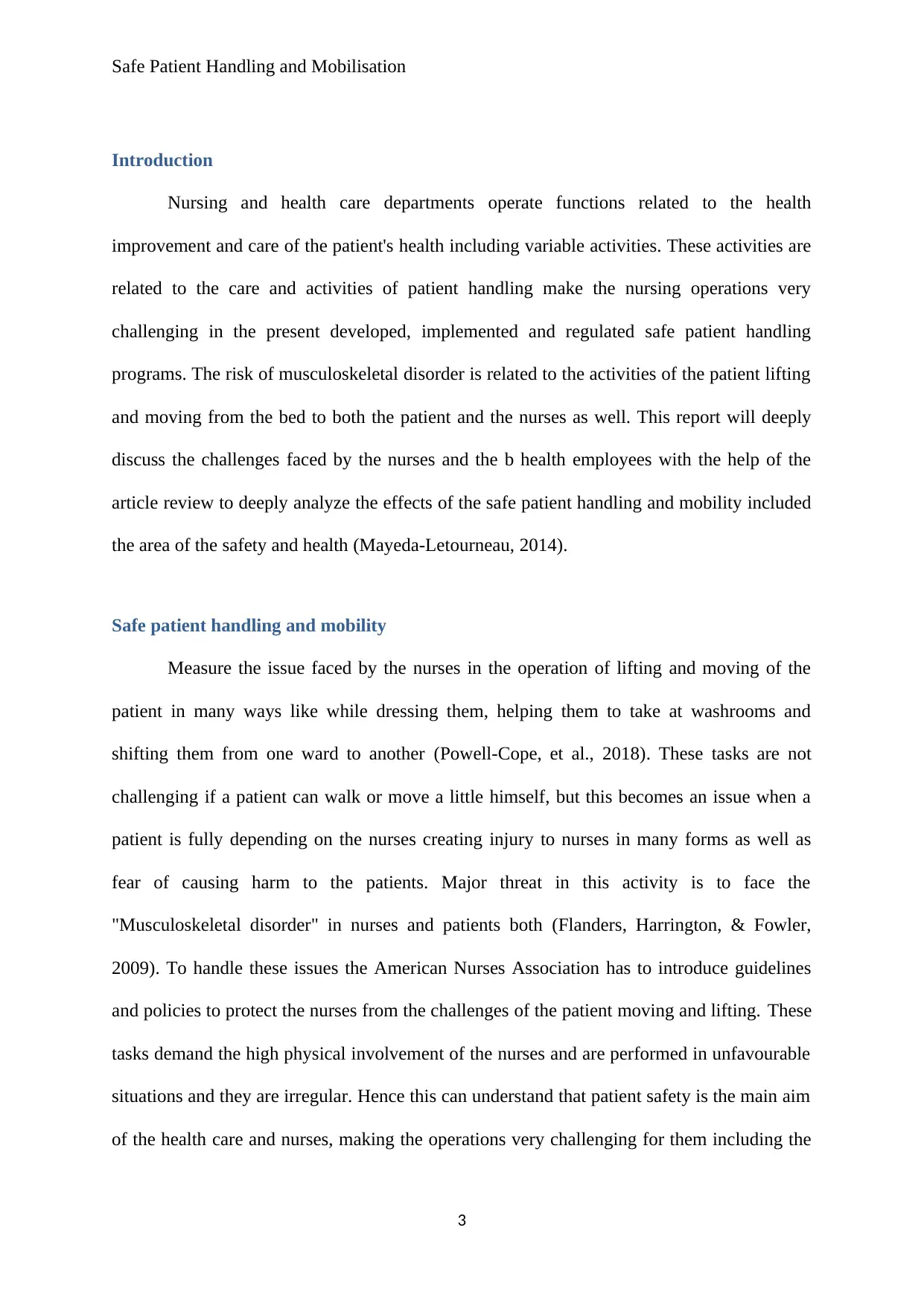
Safe Patient Handling and Mobilisation
Introduction
Nursing and health care departments operate functions related to the health
improvement and care of the patient's health including variable activities. These activities are
related to the care and activities of patient handling make the nursing operations very
challenging in the present developed, implemented and regulated safe patient handling
programs. The risk of musculoskeletal disorder is related to the activities of the patient lifting
and moving from the bed to both the patient and the nurses as well. This report will deeply
discuss the challenges faced by the nurses and the b health employees with the help of the
article review to deeply analyze the effects of the safe patient handling and mobility included
the area of the safety and health (Mayeda‐Letourneau, 2014).
Safe patient handling and mobility
Measure the issue faced by the nurses in the operation of lifting and moving of the
patient in many ways like while dressing them, helping them to take at washrooms and
shifting them from one ward to another (Powell-Cope, et al., 2018). These tasks are not
challenging if a patient can walk or move a little himself, but this becomes an issue when a
patient is fully depending on the nurses creating injury to nurses in many forms as well as
fear of causing harm to the patients. Major threat in this activity is to face the
"Musculoskeletal disorder" in nurses and patients both (Flanders, Harrington, & Fowler,
2009). To handle these issues the American Nurses Association has to introduce guidelines
and policies to protect the nurses from the challenges of the patient moving and lifting. These
tasks demand the high physical involvement of the nurses and are performed in unfavourable
situations and they are irregular. Hence this can understand that patient safety is the main aim
of the health care and nurses, making the operations very challenging for them including the
3
Introduction
Nursing and health care departments operate functions related to the health
improvement and care of the patient's health including variable activities. These activities are
related to the care and activities of patient handling make the nursing operations very
challenging in the present developed, implemented and regulated safe patient handling
programs. The risk of musculoskeletal disorder is related to the activities of the patient lifting
and moving from the bed to both the patient and the nurses as well. This report will deeply
discuss the challenges faced by the nurses and the b health employees with the help of the
article review to deeply analyze the effects of the safe patient handling and mobility included
the area of the safety and health (Mayeda‐Letourneau, 2014).
Safe patient handling and mobility
Measure the issue faced by the nurses in the operation of lifting and moving of the
patient in many ways like while dressing them, helping them to take at washrooms and
shifting them from one ward to another (Powell-Cope, et al., 2018). These tasks are not
challenging if a patient can walk or move a little himself, but this becomes an issue when a
patient is fully depending on the nurses creating injury to nurses in many forms as well as
fear of causing harm to the patients. Major threat in this activity is to face the
"Musculoskeletal disorder" in nurses and patients both (Flanders, Harrington, & Fowler,
2009). To handle these issues the American Nurses Association has to introduce guidelines
and policies to protect the nurses from the challenges of the patient moving and lifting. These
tasks demand the high physical involvement of the nurses and are performed in unfavourable
situations and they are irregular. Hence this can understand that patient safety is the main aim
of the health care and nurses, making the operations very challenging for them including the
3
Paraphrase This Document
Need a fresh take? Get an instant paraphrase of this document with our AI Paraphraser
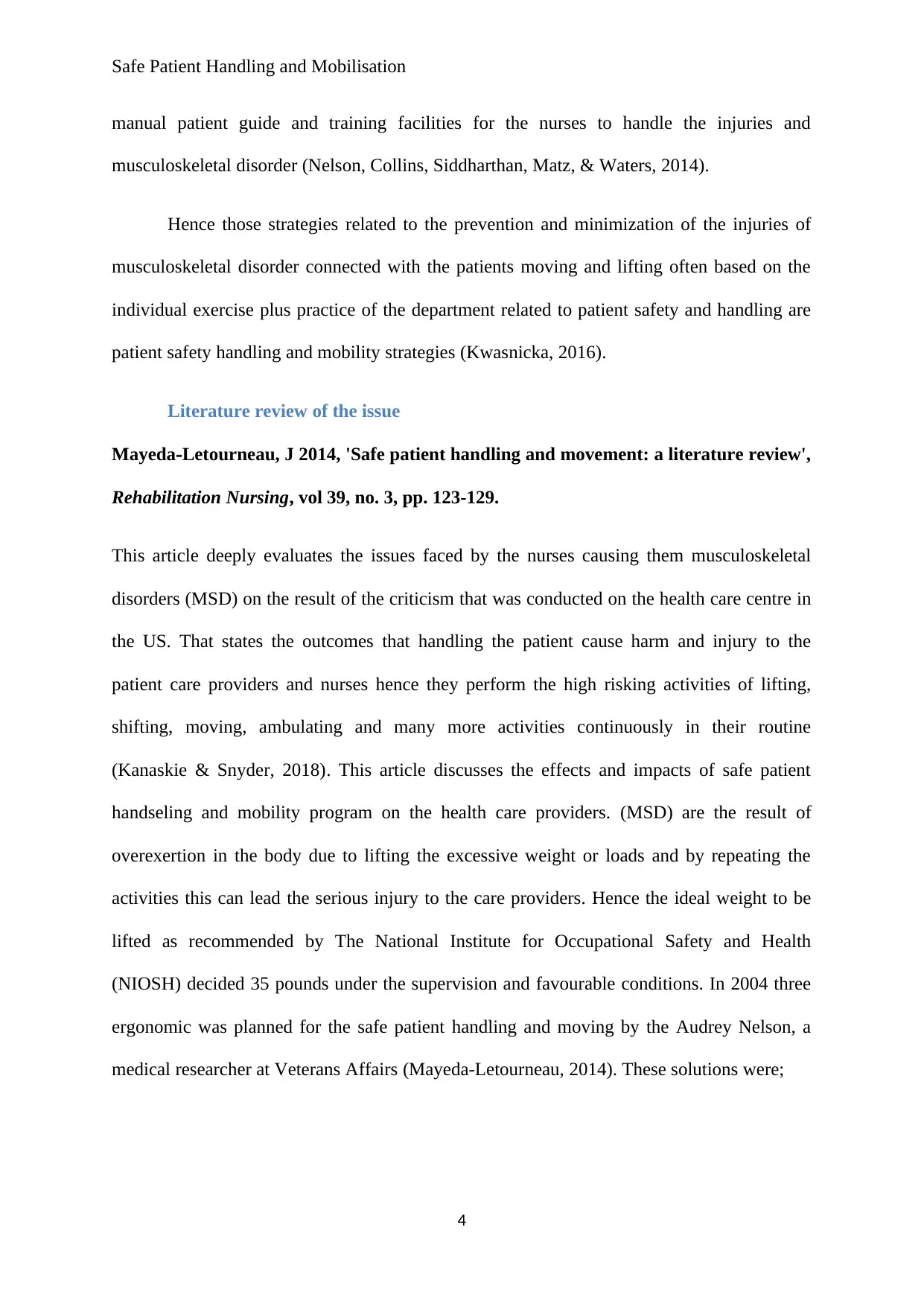
Safe Patient Handling and Mobilisation
manual patient guide and training facilities for the nurses to handle the injuries and
musculoskeletal disorder (Nelson, Collins, Siddharthan, Matz, & Waters, 2014).
Hence those strategies related to the prevention and minimization of the injuries of
musculoskeletal disorder connected with the patients moving and lifting often based on the
individual exercise plus practice of the department related to patient safety and handling are
patient safety handling and mobility strategies (Kwasnicka, 2016).
Literature review of the issue
Mayeda‐Letourneau, J 2014, 'Safe patient handling and movement: a literature review',
Rehabilitation Nursing, vol 39, no. 3, pp. 123-129.
This article deeply evaluates the issues faced by the nurses causing them musculoskeletal
disorders (MSD) on the result of the criticism that was conducted on the health care centre in
the US. That states the outcomes that handling the patient cause harm and injury to the
patient care providers and nurses hence they perform the high risking activities of lifting,
shifting, moving, ambulating and many more activities continuously in their routine
(Kanaskie & Snyder, 2018). This article discusses the effects and impacts of safe patient
handseling and mobility program on the health care providers. (MSD) are the result of
overexertion in the body due to lifting the excessive weight or loads and by repeating the
activities this can lead the serious injury to the care providers. Hence the ideal weight to be
lifted as recommended by The National Institute for Occupational Safety and Health
(NIOSH) decided 35 pounds under the supervision and favourable conditions. In 2004 three
ergonomic was planned for the safe patient handling and moving by the Audrey Nelson, a
medical researcher at Veterans Affairs (Mayeda‐Letourneau, 2014). These solutions were;
4
manual patient guide and training facilities for the nurses to handle the injuries and
musculoskeletal disorder (Nelson, Collins, Siddharthan, Matz, & Waters, 2014).
Hence those strategies related to the prevention and minimization of the injuries of
musculoskeletal disorder connected with the patients moving and lifting often based on the
individual exercise plus practice of the department related to patient safety and handling are
patient safety handling and mobility strategies (Kwasnicka, 2016).
Literature review of the issue
Mayeda‐Letourneau, J 2014, 'Safe patient handling and movement: a literature review',
Rehabilitation Nursing, vol 39, no. 3, pp. 123-129.
This article deeply evaluates the issues faced by the nurses causing them musculoskeletal
disorders (MSD) on the result of the criticism that was conducted on the health care centre in
the US. That states the outcomes that handling the patient cause harm and injury to the
patient care providers and nurses hence they perform the high risking activities of lifting,
shifting, moving, ambulating and many more activities continuously in their routine
(Kanaskie & Snyder, 2018). This article discusses the effects and impacts of safe patient
handseling and mobility program on the health care providers. (MSD) are the result of
overexertion in the body due to lifting the excessive weight or loads and by repeating the
activities this can lead the serious injury to the care providers. Hence the ideal weight to be
lifted as recommended by The National Institute for Occupational Safety and Health
(NIOSH) decided 35 pounds under the supervision and favourable conditions. In 2004 three
ergonomic was planned for the safe patient handling and moving by the Audrey Nelson, a
medical researcher at Veterans Affairs (Mayeda‐Letourneau, 2014). These solutions were;
4
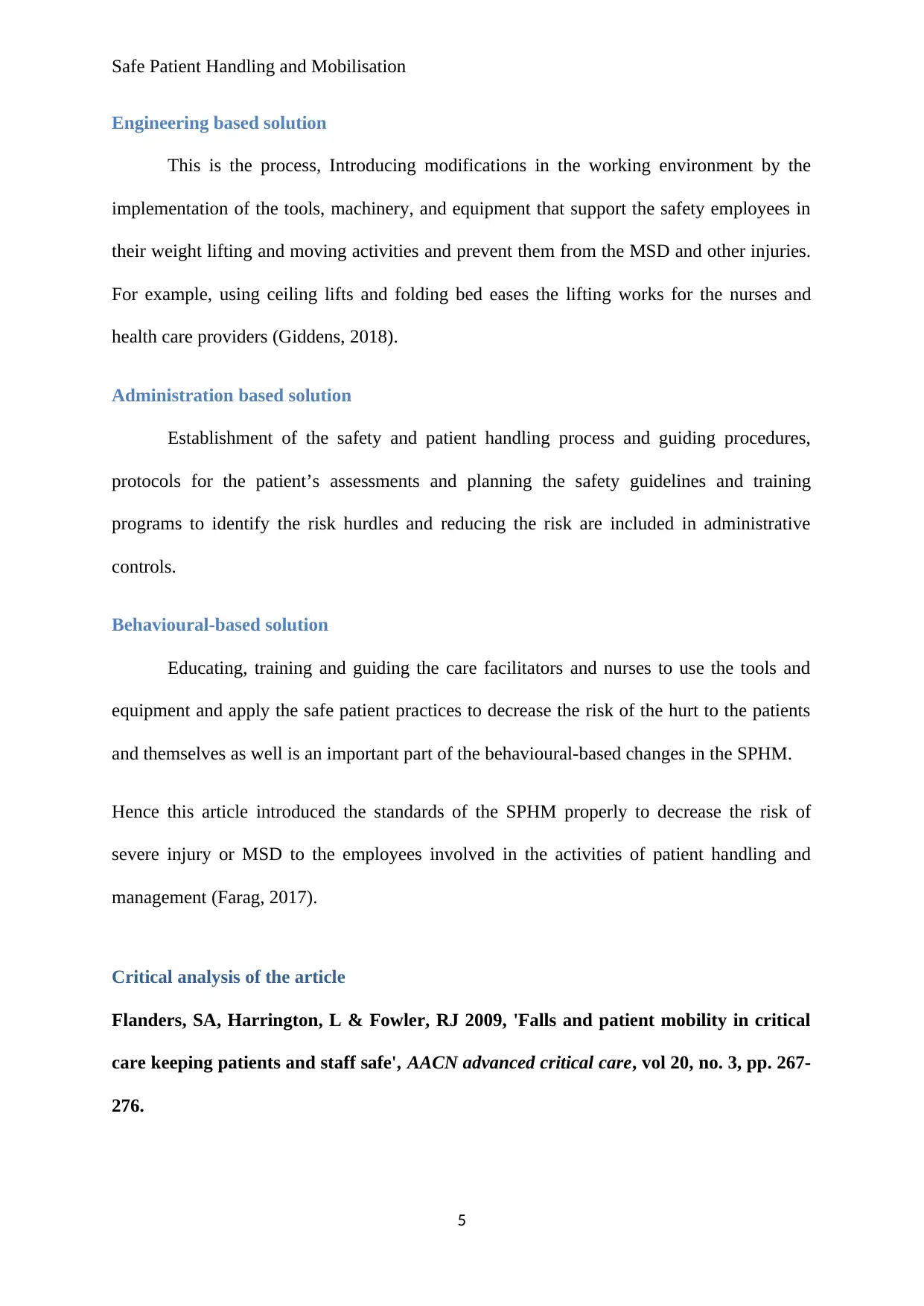
Safe Patient Handling and Mobilisation
Engineering based solution
This is the process, Introducing modifications in the working environment by the
implementation of the tools, machinery, and equipment that support the safety employees in
their weight lifting and moving activities and prevent them from the MSD and other injuries.
For example, using ceiling lifts and folding bed eases the lifting works for the nurses and
health care providers (Giddens, 2018).
Administration based solution
Establishment of the safety and patient handling process and guiding procedures,
protocols for the patient’s assessments and planning the safety guidelines and training
programs to identify the risk hurdles and reducing the risk are included in administrative
controls.
Behavioural-based solution
Educating, training and guiding the care facilitators and nurses to use the tools and
equipment and apply the safe patient practices to decrease the risk of the hurt to the patients
and themselves as well is an important part of the behavioural-based changes in the SPHM.
Hence this article introduced the standards of the SPHM properly to decrease the risk of
severe injury or MSD to the employees involved in the activities of patient handling and
management (Farag, 2017).
Critical analysis of the article
Flanders, SA, Harrington, L & Fowler, RJ 2009, 'Falls and patient mobility in critical
care keeping patients and staff safe', AACN advanced critical care, vol 20, no. 3, pp. 267-
276.
5
Engineering based solution
This is the process, Introducing modifications in the working environment by the
implementation of the tools, machinery, and equipment that support the safety employees in
their weight lifting and moving activities and prevent them from the MSD and other injuries.
For example, using ceiling lifts and folding bed eases the lifting works for the nurses and
health care providers (Giddens, 2018).
Administration based solution
Establishment of the safety and patient handling process and guiding procedures,
protocols for the patient’s assessments and planning the safety guidelines and training
programs to identify the risk hurdles and reducing the risk are included in administrative
controls.
Behavioural-based solution
Educating, training and guiding the care facilitators and nurses to use the tools and
equipment and apply the safe patient practices to decrease the risk of the hurt to the patients
and themselves as well is an important part of the behavioural-based changes in the SPHM.
Hence this article introduced the standards of the SPHM properly to decrease the risk of
severe injury or MSD to the employees involved in the activities of patient handling and
management (Farag, 2017).
Critical analysis of the article
Flanders, SA, Harrington, L & Fowler, RJ 2009, 'Falls and patient mobility in critical
care keeping patients and staff safe', AACN advanced critical care, vol 20, no. 3, pp. 267-
276.
5
⊘ This is a preview!⊘
Do you want full access?
Subscribe today to unlock all pages.

Trusted by 1+ million students worldwide
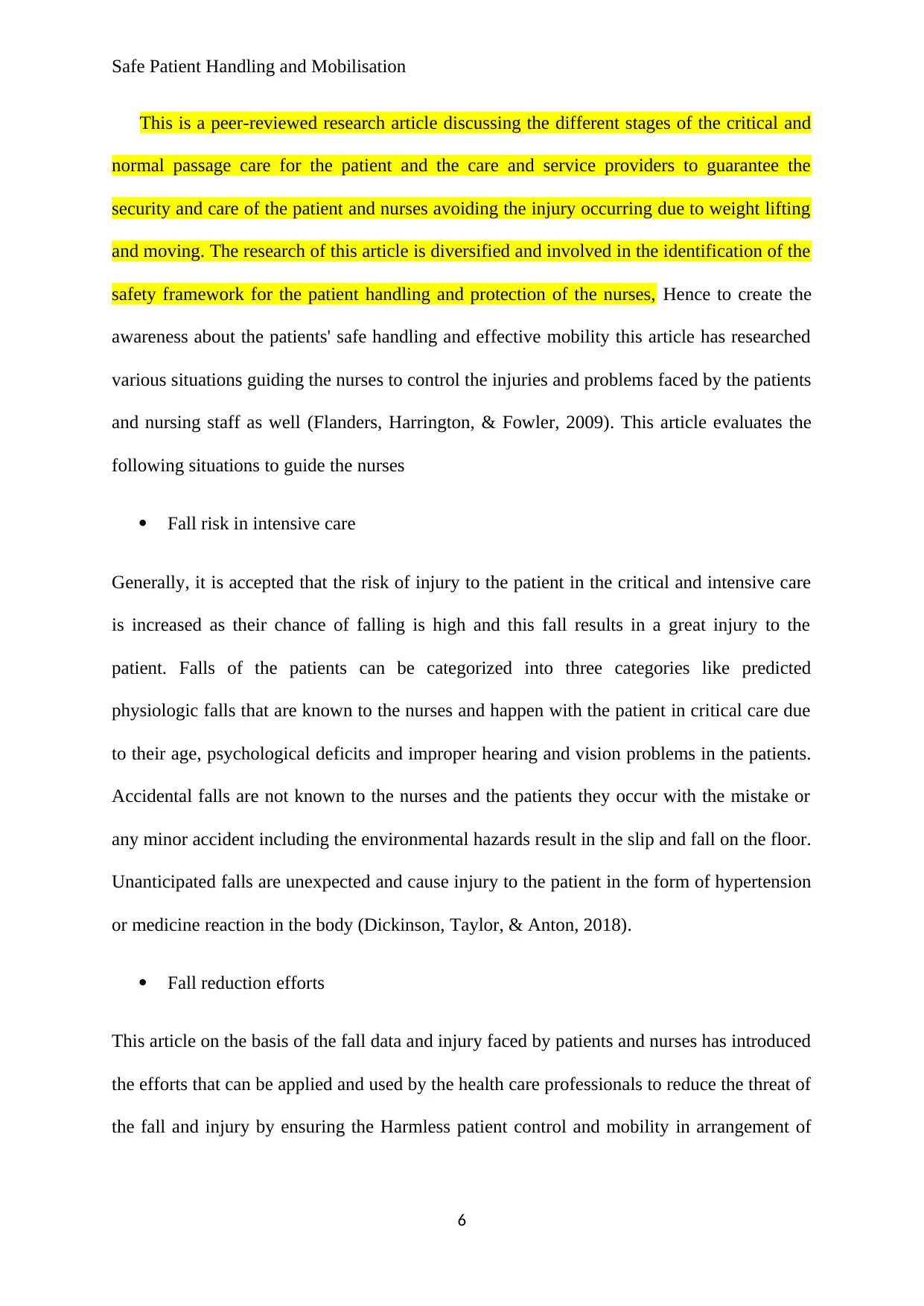
Safe Patient Handling and Mobilisation
This is a peer-reviewed research article discussing the different stages of the critical and
normal passage care for the patient and the care and service providers to guarantee the
security and care of the patient and nurses avoiding the injury occurring due to weight lifting
and moving. The research of this article is diversified and involved in the identification of the
safety framework for the patient handling and protection of the nurses, Hence to create the
awareness about the patients' safe handling and effective mobility this article has researched
various situations guiding the nurses to control the injuries and problems faced by the patients
and nursing staff as well (Flanders, Harrington, & Fowler, 2009). This article evaluates the
following situations to guide the nurses
Fall risk in intensive care
Generally, it is accepted that the risk of injury to the patient in the critical and intensive care
is increased as their chance of falling is high and this fall results in a great injury to the
patient. Falls of the patients can be categorized into three categories like predicted
physiologic falls that are known to the nurses and happen with the patient in critical care due
to their age, psychological deficits and improper hearing and vision problems in the patients.
Accidental falls are not known to the nurses and the patients they occur with the mistake or
any minor accident including the environmental hazards result in the slip and fall on the floor.
Unanticipated falls are unexpected and cause injury to the patient in the form of hypertension
or medicine reaction in the body (Dickinson, Taylor, & Anton, 2018).
Fall reduction efforts
This article on the basis of the fall data and injury faced by patients and nurses has introduced
the efforts that can be applied and used by the health care professionals to reduce the threat of
the fall and injury by ensuring the Harmless patient control and mobility in arrangement of
6
This is a peer-reviewed research article discussing the different stages of the critical and
normal passage care for the patient and the care and service providers to guarantee the
security and care of the patient and nurses avoiding the injury occurring due to weight lifting
and moving. The research of this article is diversified and involved in the identification of the
safety framework for the patient handling and protection of the nurses, Hence to create the
awareness about the patients' safe handling and effective mobility this article has researched
various situations guiding the nurses to control the injuries and problems faced by the patients
and nursing staff as well (Flanders, Harrington, & Fowler, 2009). This article evaluates the
following situations to guide the nurses
Fall risk in intensive care
Generally, it is accepted that the risk of injury to the patient in the critical and intensive care
is increased as their chance of falling is high and this fall results in a great injury to the
patient. Falls of the patients can be categorized into three categories like predicted
physiologic falls that are known to the nurses and happen with the patient in critical care due
to their age, psychological deficits and improper hearing and vision problems in the patients.
Accidental falls are not known to the nurses and the patients they occur with the mistake or
any minor accident including the environmental hazards result in the slip and fall on the floor.
Unanticipated falls are unexpected and cause injury to the patient in the form of hypertension
or medicine reaction in the body (Dickinson, Taylor, & Anton, 2018).
Fall reduction efforts
This article on the basis of the fall data and injury faced by patients and nurses has introduced
the efforts that can be applied and used by the health care professionals to reduce the threat of
the fall and injury by ensuring the Harmless patient control and mobility in arrangement of
6
Paraphrase This Document
Need a fresh take? Get an instant paraphrase of this document with our AI Paraphraser
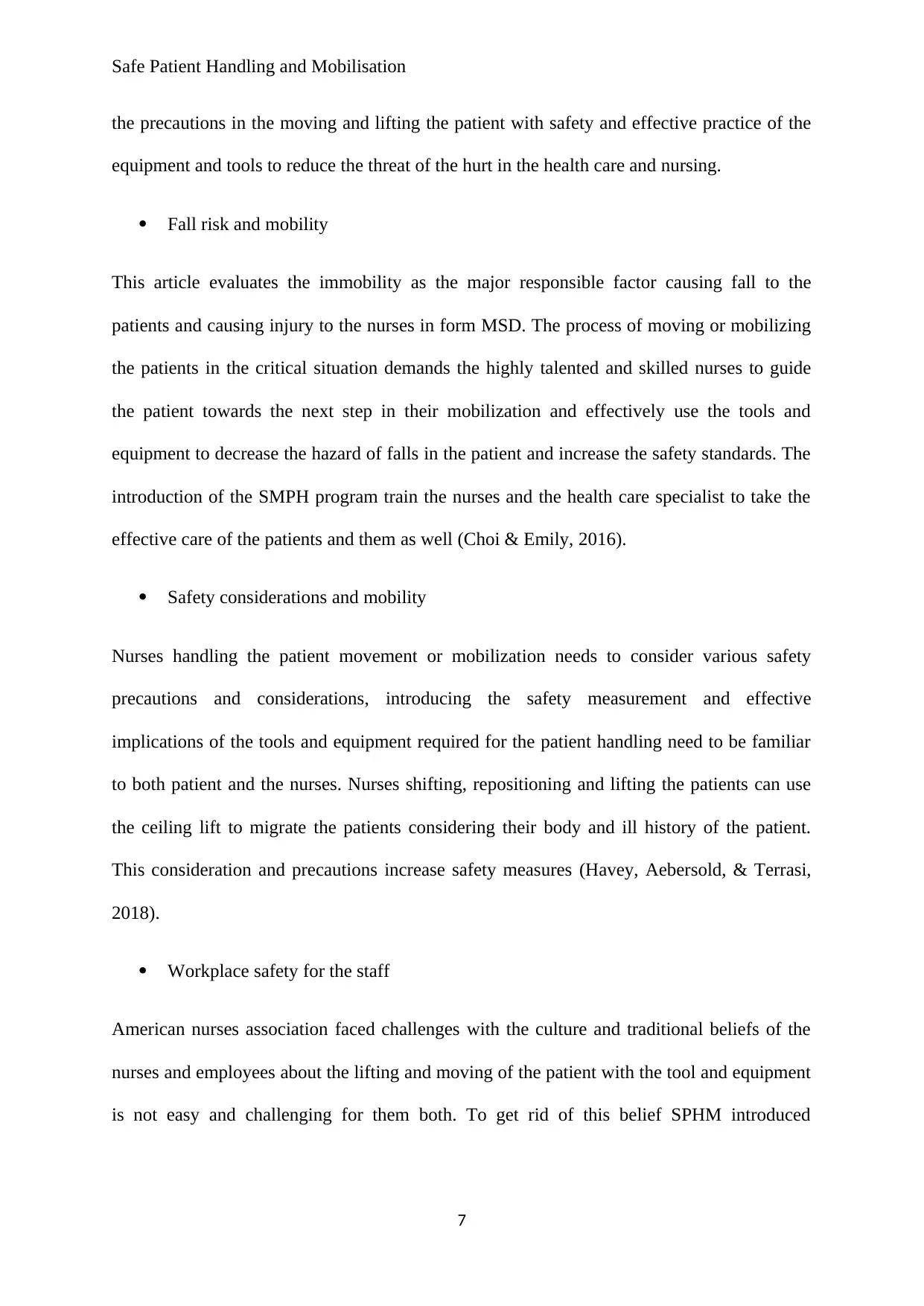
Safe Patient Handling and Mobilisation
the precautions in the moving and lifting the patient with safety and effective practice of the
equipment and tools to reduce the threat of the hurt in the health care and nursing.
Fall risk and mobility
This article evaluates the immobility as the major responsible factor causing fall to the
patients and causing injury to the nurses in form MSD. The process of moving or mobilizing
the patients in the critical situation demands the highly talented and skilled nurses to guide
the patient towards the next step in their mobilization and effectively use the tools and
equipment to decrease the hazard of falls in the patient and increase the safety standards. The
introduction of the SMPH program train the nurses and the health care specialist to take the
effective care of the patients and them as well (Choi & Emily, 2016).
Safety considerations and mobility
Nurses handling the patient movement or mobilization needs to consider various safety
precautions and considerations, introducing the safety measurement and effective
implications of the tools and equipment required for the patient handling need to be familiar
to both patient and the nurses. Nurses shifting, repositioning and lifting the patients can use
the ceiling lift to migrate the patients considering their body and ill history of the patient.
This consideration and precautions increase safety measures (Havey, Aebersold, & Terrasi,
2018).
Workplace safety for the staff
American nurses association faced challenges with the culture and traditional beliefs of the
nurses and employees about the lifting and moving of the patient with the tool and equipment
is not easy and challenging for them both. To get rid of this belief SPHM introduced
7
the precautions in the moving and lifting the patient with safety and effective practice of the
equipment and tools to reduce the threat of the hurt in the health care and nursing.
Fall risk and mobility
This article evaluates the immobility as the major responsible factor causing fall to the
patients and causing injury to the nurses in form MSD. The process of moving or mobilizing
the patients in the critical situation demands the highly talented and skilled nurses to guide
the patient towards the next step in their mobilization and effectively use the tools and
equipment to decrease the hazard of falls in the patient and increase the safety standards. The
introduction of the SMPH program train the nurses and the health care specialist to take the
effective care of the patients and them as well (Choi & Emily, 2016).
Safety considerations and mobility
Nurses handling the patient movement or mobilization needs to consider various safety
precautions and considerations, introducing the safety measurement and effective
implications of the tools and equipment required for the patient handling need to be familiar
to both patient and the nurses. Nurses shifting, repositioning and lifting the patients can use
the ceiling lift to migrate the patients considering their body and ill history of the patient.
This consideration and precautions increase safety measures (Havey, Aebersold, & Terrasi,
2018).
Workplace safety for the staff
American nurses association faced challenges with the culture and traditional beliefs of the
nurses and employees about the lifting and moving of the patient with the tool and equipment
is not easy and challenging for them both. To get rid of this belief SPHM introduced
7
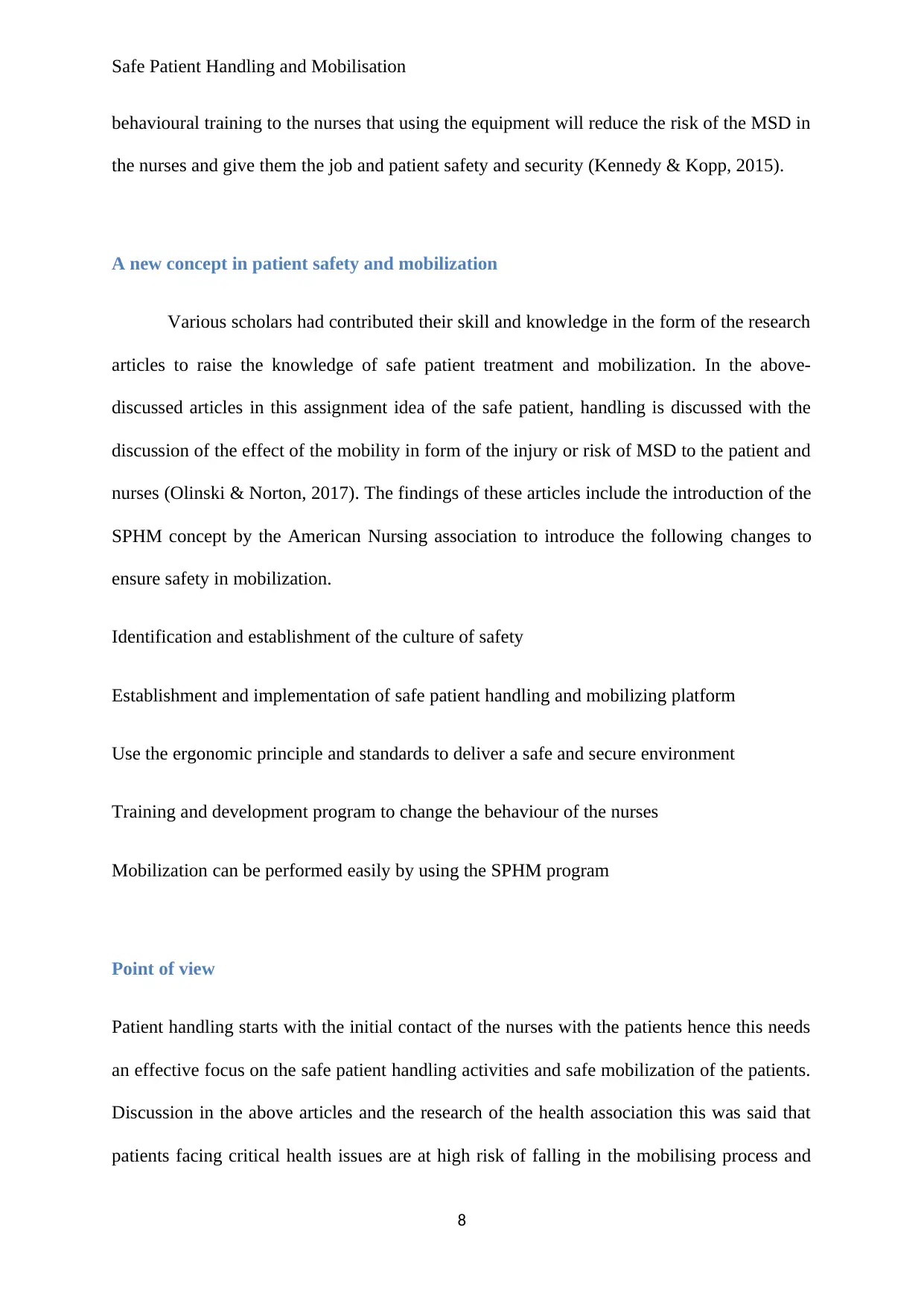
Safe Patient Handling and Mobilisation
behavioural training to the nurses that using the equipment will reduce the risk of the MSD in
the nurses and give them the job and patient safety and security (Kennedy & Kopp, 2015).
A new concept in patient safety and mobilization
Various scholars had contributed their skill and knowledge in the form of the research
articles to raise the knowledge of safe patient treatment and mobilization. In the above-
discussed articles in this assignment idea of the safe patient, handling is discussed with the
discussion of the effect of the mobility in form of the injury or risk of MSD to the patient and
nurses (Olinski & Norton, 2017). The findings of these articles include the introduction of the
SPHM concept by the American Nursing association to introduce the following changes to
ensure safety in mobilization.
Identification and establishment of the culture of safety
Establishment and implementation of safe patient handling and mobilizing platform
Use the ergonomic principle and standards to deliver a safe and secure environment
Training and development program to change the behaviour of the nurses
Mobilization can be performed easily by using the SPHM program
Point of view
Patient handling starts with the initial contact of the nurses with the patients hence this needs
an effective focus on the safe patient handling activities and safe mobilization of the patients.
Discussion in the above articles and the research of the health association this was said that
patients facing critical health issues are at high risk of falling in the mobilising process and
8
behavioural training to the nurses that using the equipment will reduce the risk of the MSD in
the nurses and give them the job and patient safety and security (Kennedy & Kopp, 2015).
A new concept in patient safety and mobilization
Various scholars had contributed their skill and knowledge in the form of the research
articles to raise the knowledge of safe patient treatment and mobilization. In the above-
discussed articles in this assignment idea of the safe patient, handling is discussed with the
discussion of the effect of the mobility in form of the injury or risk of MSD to the patient and
nurses (Olinski & Norton, 2017). The findings of these articles include the introduction of the
SPHM concept by the American Nursing association to introduce the following changes to
ensure safety in mobilization.
Identification and establishment of the culture of safety
Establishment and implementation of safe patient handling and mobilizing platform
Use the ergonomic principle and standards to deliver a safe and secure environment
Training and development program to change the behaviour of the nurses
Mobilization can be performed easily by using the SPHM program
Point of view
Patient handling starts with the initial contact of the nurses with the patients hence this needs
an effective focus on the safe patient handling activities and safe mobilization of the patients.
Discussion in the above articles and the research of the health association this was said that
patients facing critical health issues are at high risk of falling in the mobilising process and
8
⊘ This is a preview!⊘
Do you want full access?
Subscribe today to unlock all pages.

Trusted by 1+ million students worldwide
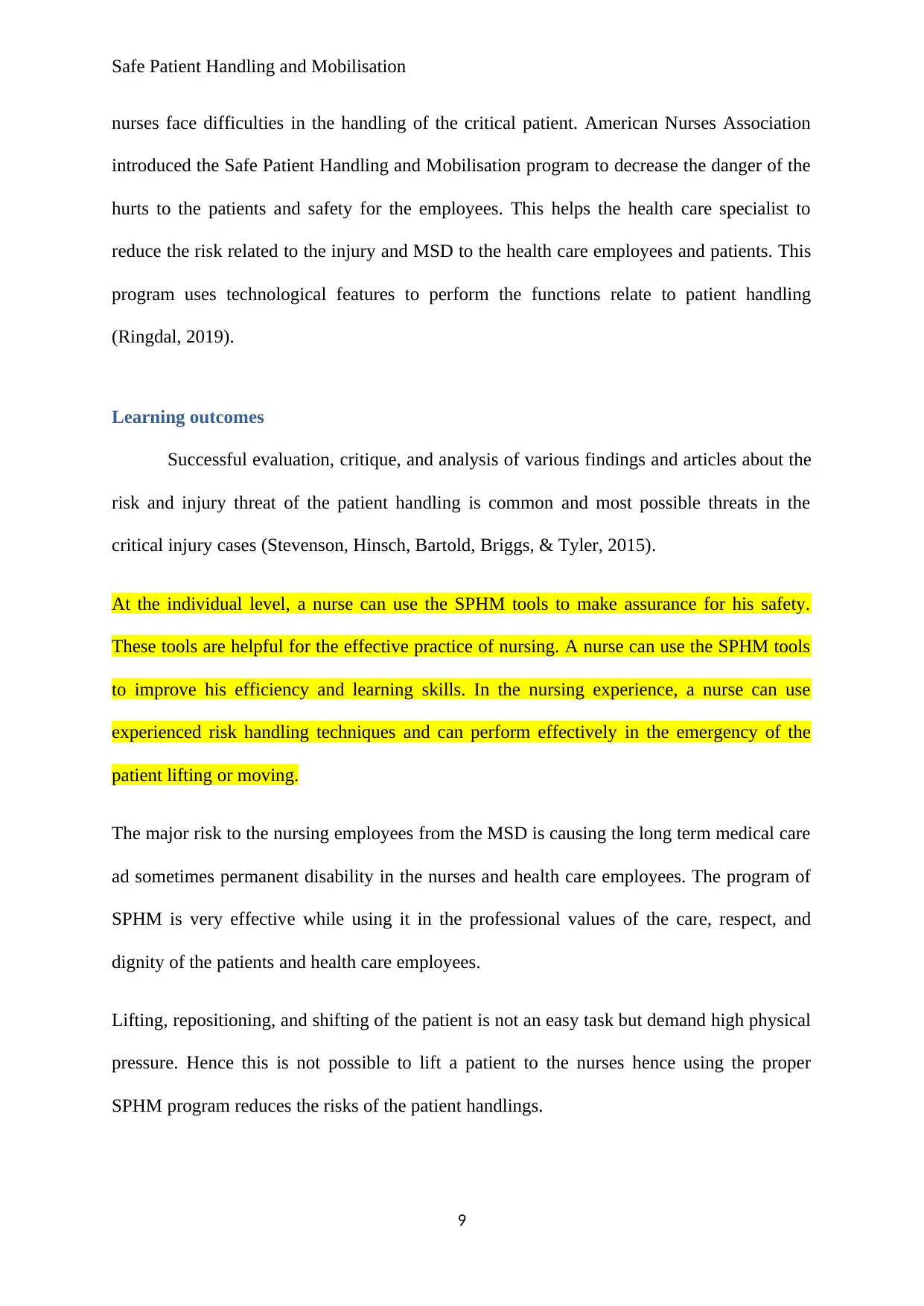
Safe Patient Handling and Mobilisation
nurses face difficulties in the handling of the critical patient. American Nurses Association
introduced the Safe Patient Handling and Mobilisation program to decrease the danger of the
hurts to the patients and safety for the employees. This helps the health care specialist to
reduce the risk related to the injury and MSD to the health care employees and patients. This
program uses technological features to perform the functions relate to patient handling
(Ringdal, 2019).
Learning outcomes
Successful evaluation, critique, and analysis of various findings and articles about the
risk and injury threat of the patient handling is common and most possible threats in the
critical injury cases (Stevenson, Hinsch, Bartold, Briggs, & Tyler, 2015).
At the individual level, a nurse can use the SPHM tools to make assurance for his safety.
These tools are helpful for the effective practice of nursing. A nurse can use the SPHM tools
to improve his efficiency and learning skills. In the nursing experience, a nurse can use
experienced risk handling techniques and can perform effectively in the emergency of the
patient lifting or moving.
The major risk to the nursing employees from the MSD is causing the long term medical care
ad sometimes permanent disability in the nurses and health care employees. The program of
SPHM is very effective while using it in the professional values of the care, respect, and
dignity of the patients and health care employees.
Lifting, repositioning, and shifting of the patient is not an easy task but demand high physical
pressure. Hence this is not possible to lift a patient to the nurses hence using the proper
SPHM program reduces the risks of the patient handlings.
9
nurses face difficulties in the handling of the critical patient. American Nurses Association
introduced the Safe Patient Handling and Mobilisation program to decrease the danger of the
hurts to the patients and safety for the employees. This helps the health care specialist to
reduce the risk related to the injury and MSD to the health care employees and patients. This
program uses technological features to perform the functions relate to patient handling
(Ringdal, 2019).
Learning outcomes
Successful evaluation, critique, and analysis of various findings and articles about the
risk and injury threat of the patient handling is common and most possible threats in the
critical injury cases (Stevenson, Hinsch, Bartold, Briggs, & Tyler, 2015).
At the individual level, a nurse can use the SPHM tools to make assurance for his safety.
These tools are helpful for the effective practice of nursing. A nurse can use the SPHM tools
to improve his efficiency and learning skills. In the nursing experience, a nurse can use
experienced risk handling techniques and can perform effectively in the emergency of the
patient lifting or moving.
The major risk to the nursing employees from the MSD is causing the long term medical care
ad sometimes permanent disability in the nurses and health care employees. The program of
SPHM is very effective while using it in the professional values of the care, respect, and
dignity of the patients and health care employees.
Lifting, repositioning, and shifting of the patient is not an easy task but demand high physical
pressure. Hence this is not possible to lift a patient to the nurses hence using the proper
SPHM program reduces the risks of the patient handlings.
9
Paraphrase This Document
Need a fresh take? Get an instant paraphrase of this document with our AI Paraphraser
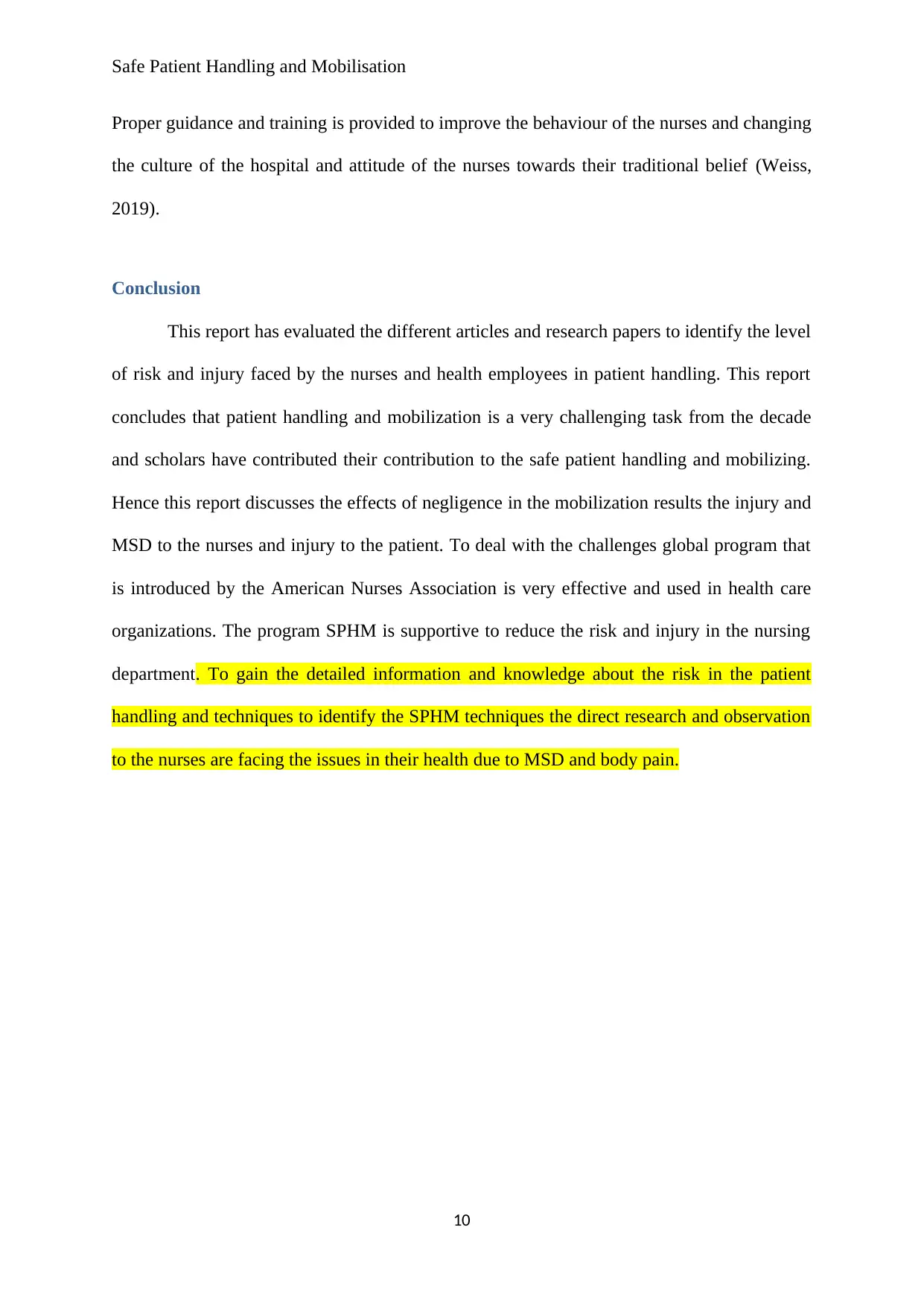
Safe Patient Handling and Mobilisation
Proper guidance and training is provided to improve the behaviour of the nurses and changing
the culture of the hospital and attitude of the nurses towards their traditional belief (Weiss,
2019).
Conclusion
This report has evaluated the different articles and research papers to identify the level
of risk and injury faced by the nurses and health employees in patient handling. This report
concludes that patient handling and mobilization is a very challenging task from the decade
and scholars have contributed their contribution to the safe patient handling and mobilizing.
Hence this report discusses the effects of negligence in the mobilization results the injury and
MSD to the nurses and injury to the patient. To deal with the challenges global program that
is introduced by the American Nurses Association is very effective and used in health care
organizations. The program SPHM is supportive to reduce the risk and injury in the nursing
department. To gain the detailed information and knowledge about the risk in the patient
handling and techniques to identify the SPHM techniques the direct research and observation
to the nurses are facing the issues in their health due to MSD and body pain.
10
Proper guidance and training is provided to improve the behaviour of the nurses and changing
the culture of the hospital and attitude of the nurses towards their traditional belief (Weiss,
2019).
Conclusion
This report has evaluated the different articles and research papers to identify the level
of risk and injury faced by the nurses and health employees in patient handling. This report
concludes that patient handling and mobilization is a very challenging task from the decade
and scholars have contributed their contribution to the safe patient handling and mobilizing.
Hence this report discusses the effects of negligence in the mobilization results the injury and
MSD to the nurses and injury to the patient. To deal with the challenges global program that
is introduced by the American Nurses Association is very effective and used in health care
organizations. The program SPHM is supportive to reduce the risk and injury in the nursing
department. To gain the detailed information and knowledge about the risk in the patient
handling and techniques to identify the SPHM techniques the direct research and observation
to the nurses are facing the issues in their health due to MSD and body pain.
10
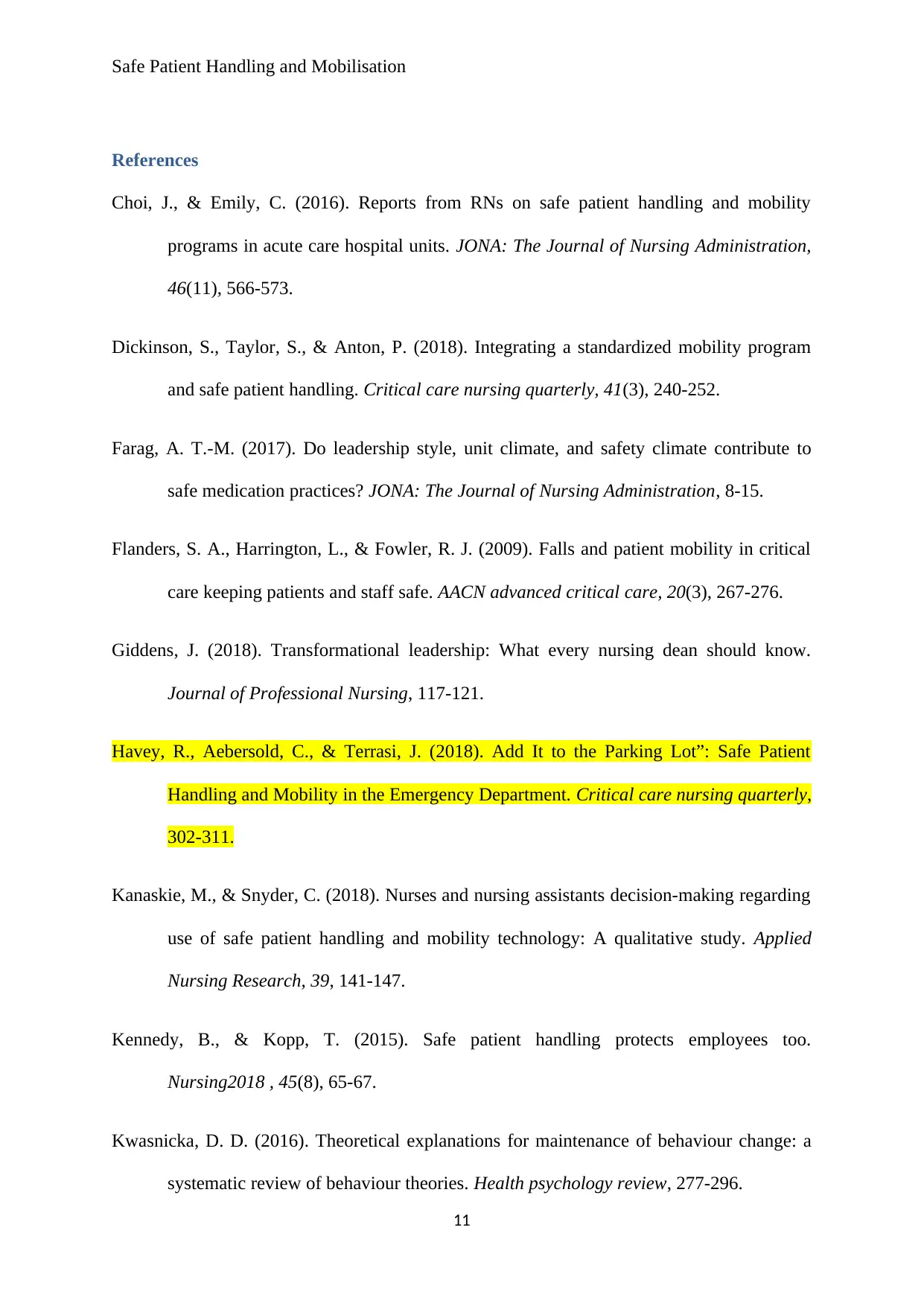
Safe Patient Handling and Mobilisation
References
Choi, J., & Emily, C. (2016). Reports from RNs on safe patient handling and mobility
programs in acute care hospital units. JONA: The Journal of Nursing Administration,
46(11), 566-573.
Dickinson, S., Taylor, S., & Anton, P. (2018). Integrating a standardized mobility program
and safe patient handling. Critical care nursing quarterly, 41(3), 240-252.
Farag, A. T.-M. (2017). Do leadership style, unit climate, and safety climate contribute to
safe medication practices? JONA: The Journal of Nursing Administration, 8-15.
Flanders, S. A., Harrington, L., & Fowler, R. J. (2009). Falls and patient mobility in critical
care keeping patients and staff safe. AACN advanced critical care, 20(3), 267-276.
Giddens, J. (2018). Transformational leadership: What every nursing dean should know.
Journal of Professional Nursing, 117-121.
Havey, R., Aebersold, C., & Terrasi, J. (2018). Add It to the Parking Lot”: Safe Patient
Handling and Mobility in the Emergency Department. Critical care nursing quarterly,
302-311.
Kanaskie, M., & Snyder, C. (2018). Nurses and nursing assistants decision-making regarding
use of safe patient handling and mobility technology: A qualitative study. Applied
Nursing Research, 39, 141-147.
Kennedy, B., & Kopp, T. (2015). Safe patient handling protects employees too.
Nursing2018 , 45(8), 65-67.
Kwasnicka, D. D. (2016). Theoretical explanations for maintenance of behaviour change: a
systematic review of behaviour theories. Health psychology review, 277-296.
11
References
Choi, J., & Emily, C. (2016). Reports from RNs on safe patient handling and mobility
programs in acute care hospital units. JONA: The Journal of Nursing Administration,
46(11), 566-573.
Dickinson, S., Taylor, S., & Anton, P. (2018). Integrating a standardized mobility program
and safe patient handling. Critical care nursing quarterly, 41(3), 240-252.
Farag, A. T.-M. (2017). Do leadership style, unit climate, and safety climate contribute to
safe medication practices? JONA: The Journal of Nursing Administration, 8-15.
Flanders, S. A., Harrington, L., & Fowler, R. J. (2009). Falls and patient mobility in critical
care keeping patients and staff safe. AACN advanced critical care, 20(3), 267-276.
Giddens, J. (2018). Transformational leadership: What every nursing dean should know.
Journal of Professional Nursing, 117-121.
Havey, R., Aebersold, C., & Terrasi, J. (2018). Add It to the Parking Lot”: Safe Patient
Handling and Mobility in the Emergency Department. Critical care nursing quarterly,
302-311.
Kanaskie, M., & Snyder, C. (2018). Nurses and nursing assistants decision-making regarding
use of safe patient handling and mobility technology: A qualitative study. Applied
Nursing Research, 39, 141-147.
Kennedy, B., & Kopp, T. (2015). Safe patient handling protects employees too.
Nursing2018 , 45(8), 65-67.
Kwasnicka, D. D. (2016). Theoretical explanations for maintenance of behaviour change: a
systematic review of behaviour theories. Health psychology review, 277-296.
11
⊘ This is a preview!⊘
Do you want full access?
Subscribe today to unlock all pages.

Trusted by 1+ million students worldwide
1 out of 13
Related Documents
Your All-in-One AI-Powered Toolkit for Academic Success.
+13062052269
info@desklib.com
Available 24*7 on WhatsApp / Email
![[object Object]](/_next/static/media/star-bottom.7253800d.svg)
Unlock your academic potential
Copyright © 2020–2025 A2Z Services. All Rights Reserved. Developed and managed by ZUCOL.





